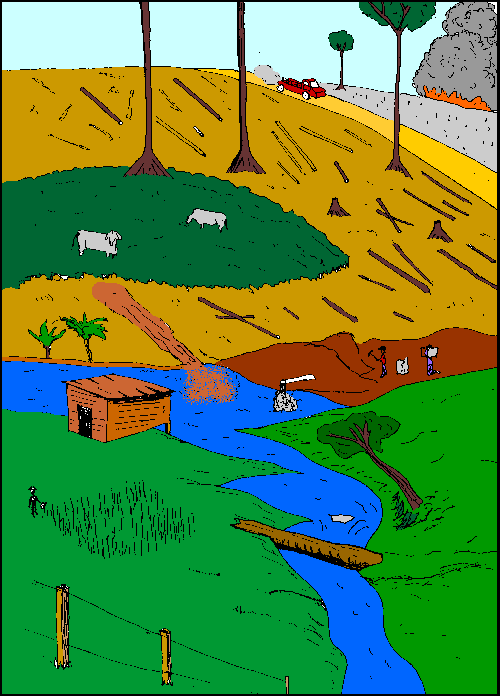![[internet geography]](../images/pagelayout/netgeologo.gif)
![]()
Physical Geography
Coasts
Earthquake
Ecosystems
Glaciation
Limestone
Plate Tectonics
Rivers
Volcanoes
Weather and climate
National Parks
Human Geography
Landuse
Migration
Urbanisation
Economic Geography

|
Tropical
Rainforest
|
| <Back to Ecosystems |
|
Where are tropical rainforests found?
Tropical rainforests are located around the equator where temperatures stay near 80 degrees year round. Rainforests receive 160 to 400 inches (400-1000 cm) of rain each year. The largest rainforests are in Brazil (South America), Zaire (Africa) and Indonesia (South East Asia). Other tropical rainforest places are in Hawaii and the islands of the Pacific & Caribbean. What is the tropical rainforest?
The Tropical Rainforest is a forest occurring in tropical areas of heavy rainfall. It is abundant with many species of wildlife and vegetation. Rainforests cover less than two percent of the Earth's surface. They are home to some 50 to 70 percent of all life forms on our planet. Rainforests are the most productive and most complex ecosystems on Earth. What is the structure of vegetation in the rainforest?
Emergents are the tallest trees and are usually over 50 metres tall. The Kapok tree is an example of an emergent. The sea of leaves blocking out the sun from the lower layers is called the canopy. The canopy contains over 50% of the rainforest wildlife. This includes birds, snakes and monkeys. Lianas (vines) climb to the canopy to reach this sun light. The under canopy mainly contains bare tree trunks and lianas. The shrub layer has the densest plant growth. It contains shrubs and ferns and other plants needing less light. Saplings of emergents and canopy trees can also be found here. The forest floor is usually dark and damp. It contains a layer of rotting leaves and dead animals called litter. This decomposes rapidly (within 6 weeks) to form a thin humus, rich in nutrients. How did the tropical rainforest get like this?
The high rainfall and year-round high temperatures are ideal conditions for vegetation growth. The wide range of plants encourage a huge variety of insects, birds and animals. What is the impact of humans on the tropical rainforest?
Deforestation (cutting down trees) is a major problem caused by humans in the tropical rainforest. Global Rates of Deforestation:
The image below shows some of the causes and effects of deforestation in the Amazon Rainforest. Place you mouse over the image to disover these causes and effects. Click to view infomation on each factor.
Slash
and burn Logging
Cattle
Ranching Hydroelectric
Power Farming
Mining
Deforestation is causing many problems at a range of scales: Local: Ecosystem
Soil Erosion
National:
Global:
Global Warming What is the future for the tropical rainforest? - Sustainable Development
If development in the rainforest is to be sustainable (e.g. although the resources are used to aid development, it/they will still exist for future generations to use) a number of measures must be taken. These include: Afforestation - Trees should be replanted in areas of deforestation. Shifting Cultivation - Farmers should move on after 2-3 years to allow the rainforest to recover. Rubber tapping - More sustainable methods of exploiting the rainforest should be pursued e.g. rubber tapping Measuring trees - Trees should only be cut down when they reach a certain size. This will ensure younger trees survive longer and will encourage careful management of the rainforest. |
![]()
GeoNet is not responsible for the content of any of these sites
The Evergreen Project - Biomes of the world
Why are the rainforests so important to the world?
Help
with rainforest reports
An excellent site with lots of useful links
![[cross section in the rainforest]](../images/ecosystems/crosssection1.gif)
